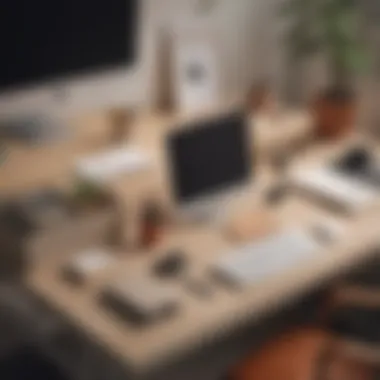Marie Kondo Desk Organization Tips for a Productive Workspace


Intro
In today’s fast-paced and ever-demanding work environment, maintaining an organized desk is essential. Many people feel overwhelmed by clutter and disorganization in their workspace. This is where Marie Kondo’s principles, which focus on decluttering and creating a harmonious space, come into play. Her method not only enhances functionality but also transforms the aesthetic appeal of your workspace.
Kondo’s approach emphasizes keeping only those items that spark joy. This allows individuals to assess their belongings critically and retain only what is essential. The benefits of applying her techniques go beyond merely clearing a desk—they include fostering productivity and enhancing overall mental well-being.
In this guide, we will explore how to apply Marie Kondo's ideologies to your desk organization. Not only will the conventional criteria of tidiness be reviewed but also how different elements can come together for a workspace designed for both efficiency and pleasure.
Decluttering Your Desk
The first step in your organizational journey is decluttering. Kondo suggests categorizing items into those often used, others sacred, and trivial belongings. Go through your papers, stationery, and personal knick-knacks one by one. Ask yourself if these items establish a positive environment.
- Set aside a specific time to declutter. Allocate at least 30 minutes to begin with.
- Create a sorting system. Use designated boxes or areas for ‘keep’, ‘discard’, and ‘donate’ items.
- Utilize the ‘Spark Joy’ method. Hold each item and ask, does it spark joy?
Implementing these principles helps to see which items are just occupying space versus those that genuinely add value to your professional life.
Arrangement Techniques
Next, the arrangement of the items on your desk requires careful consideration as well. According to Kondo, the way we place items influences our work flow. Here are some aspects to consider:
- Prioritize accessibility. Keep often-used items within arm's reach to facilitate efficiency.
- Form groups based on function. Create designated spots for specific tasks, like one area for computer accessories and another for paperwork.
- Embrace vertical space. Utilize vertical shelves or wall mounts for storage, freeing up desk space.
By adjusting where and how you place items on your desk, you will create a workspace that radiates clarity and gives off a sense of purpose.
Maintenance Strategies
Finally, simple maintenance strategies complement Kondo’s techniques for long-term organization success. Continuous dedication to proper desk upkeep prevents subsequently falling into the clutter trap again.
- Establish success routines. Spend five minutes at the end of each day tidying up, ensuring everything has a home.
- Reevaluate periodically. Set a monthly schedule to examine your ongoing 'keep' items and rediscover their relevance.
Through routine evaluations and specific tasks, your organized desk can become a core of productivity and creativity, which Kondo deeply advocates.''
The End
Understanding Marie Kondo's Philosophy
Marie Kondo's approach to organization is rooted in a deep philosophy that goes far beyond simple tidiness. Understanding her philosophy is crucial for maximizing the benefits of her methods, especially when it comes to desk organization. Kondo's methods encourage not only the physical decluttering of your workspace but also mental clarity and emotional well-being.
The core element here is the emphasis on joy. When one reorganizes their desk according to Kondo's standards, it becomes not just neat but a reflection of personal values and interests. This leads to a workspace that inspires productivity and creativity. Hence, merely tossing out papers and old coffee cups isn't sufficient; you must consider the significance of each item in your space, leading to thoughtful decision-making.
"A cluttered space leads to a cluttered mind" is a notion that aligns with Kondo's belief in the emotional impact of our environment.
By re-evaluating surrounding items and the environment, individuals can identify what brings them joy. This can serve as a motivational force that encourages care in maintaining a organized workspace. Kondo prompt an individual responsible for their space by considering what they truly need and treasure.
The foundation of her philosophy is cylindrical; it's built on the necessity of intentionality. Setting an intention lays the groundwork for a successful desk organization and immaculately tidy office.
The Spark Joy Principle
At the heart of Kondo's philosophy is the concept of
Assessing Your Desk Space
Assessing your desk space is paramount before diving into the decluttering and organizing processes. In this section, we will explore why understanding the state of your workspace can substantially enhance your experience of Marie Kondo’s techniques. Additionally, it helps prevent inefficient habits and promotes long-term satisfaction with your updated setup.
The way your workspace is arranged can either empower or hinder your productivity. A chaotic environment often leads to increased stress levels, distractions, and a reduced capacity for focus. On the contrary, an organized desk provides clarity, making it easier to locate essential items when needed. Consequently, creating an atmosphere that allows creativity and efficiency is essential.
Identifying Clutter Triggers


One of the first steps in this assessment is identifying clutter triggers. Often, certain items tend to accumulate over time, turning your workspace into a disorganized area. These triggers can be anything from paperwork piles, unused office supplies, or personal knick-knacks gathering dust. Recognizing what exactly causes clutter within your environment is vital for future maintenance.
- Types of Clutter Triggers:
- Excessive Paperwork: Often, papers related to tasks, bills, or simple notes pile up. Set a time to review and recycle unnecessary papers regularly.
- Unnecessary Items: Multiple pens that do not work, unused gadgets, or decor not adding value can quickly turn your desk into clutter.
- Digital Clutter: A chaotic desktop and numerous unorganized files may also contribute to a cluttered mind.
By examining these triggers, one can create a focused plan to prevent accumulation in the future.
Evaluating Current Desk Layout
The next step involves evaluating the current desk layout. An effective desk layout supports your workflow and energy. Start by classifying each item's role and observing its position on your desk.
Some key points to think about are:
- Functionality: Every item should have a purpose. Consider if every item enhances productivity or satisfaction.
- Accessibility: Items that you frequently use should be within easy reach, while rarely used items can stay out of sight.
- Workspace Zones: Determine if your existing arrangement allows for different zones, like an area for studying, crafting, or handling administrative tasks. Setting these practical distinctions can elevate efficiency remarkably.
Carefully assessing both triggers and layout creates a foundation for successful organization based on your individual needs. Changing how your desk is set up can lead to significant benefits that resonate throughout your work-life balance.
Decluttering Your Desk
Decluttering your desk is essential in creating an organized workspace that fosters focus and productivity. A cluttered desk can create distraction and mental fatigue. In contrast, a tidy work环境 enhances clarity of thought and efficiency in tasks. Following the principles of Marie Kondo, decluttering your desk involves thoughtful evaluation and systematic processes to evaluate what items are truly necessary. Prioritizing the significance of this stage paves the way for maintaining an efficient workspace long-term.
The Five-Step Decluttering Process
To effectively declutter your desk, the five-step process outlined by Marie Kondo can guide your efforts. These steps are:
- Commit yourself to decluttering: Make a firm decision to declutter your workspace. This stage helps to mentally prepare you to part with items that do not serve a purpose.
- Visualize your ideal office: Spend time imagining what an organized desk looks like to you, emphasizing how it will support your work and well-being.
- Take everything out: Clear your workspace entirely. Viewing all items at once provides perspective on what you have and how they connect to your work.
- Ask the critical question: Employ Kondo's defining question:
Organizing Your Desk Items
Organizing your desk items is crucial for creating a workspace that enhances efficiency and individual comfort. It is not simply about tidiness; rather, it directly influences productivity and mental clarity. When items are allocated their specific zones, it becomes easier to access necessary tools without losing time in searching. Additionally, a well-organized space promotes a sense of control, leading to improved morale.
Zoning Your Workspace
Zoning refers to the practice of dividing your desk into specific areas or regions that serve distinct purposes. This concept allows you to categorize your activities and tools around those distinct zones. For example, you might have a zone dedicated to computer work, another for paperwork, and a third for reference materials.
By implementing zones, you increase efficiency. You no longer need to sift through unrelated items to find what you need. Moreover, zoning encourages set transitions between tasks, which can improve focus. An effective zone configuration reflects your workflow habits, integrating them into your physical setup.
Practical Storage Solutions
Practical storage solutions are essential for maintaining an organized workspace. Here are three effective options:
Drawer Organizers
Discussing Drawer Organizers, the specific aspect revolves around maximizing the storage potential of drawer spaces. This method helps achieve order amidst chaos. The key characteristic of Drawer Organizers is their ability to compartmentalize small items, like pens, paper clips, and sticky notes. This framework makes them a popular choice because they neatly arrange materials, allowing items to be found quickly when needed.
One unique feature of Drawer Organizers is the modular design that adjusts to various drawer sizes. However, while they offer excellent organization, it’s worth noting that overstuffing a drawer can lead to confusion again, thus occasional reassessment is necessary.
Desktop Trays
Desktop Trays focus on maintaining a clean and functional surface area. Their contribution aligns closely with the goal of keeping items at arm's reach yet unobtrusive. The key characteristic of Desktop Trays is their ability to hold documents or essential tools while remaining visible. This feature saves time when looking for frequently used items, making them a valuable addition to one’s desk.
However, one must be cautious about overcrowding trays. While they provide organization and easy access, too many items may create visual chaos. It is key to keep stacked papers and supplies limited, which ensures the desk does not feel cramped.
File Management Systems
File Management Systems are integral for maintaining meaningful records while ensuring space isn't overwhelmed by unnecessary paper piles. Their most significant characteristic is organized categorization, which makes locating documents straightforward. These systems typically include folders, binders, and digital solutions, all designed to support clear document paths.
The unique feature distinguishing these systems is versatility. Providing both physical and digital file options allows individual users to select based on their workstyles. Despite their adaptability, the disadvantage lies in the risk of letting files pile up quickly; maintaining regular organization prevents clutter buildup and supports sustained productivity.
In summary, organizing your desk is enhanced significantly by integrating practical methods such as zoning and utilizing effective storage solutions. The benefits of these systems directly impact productivity, reduce stress, and create a workspace that you will be excited to engage with daily.


Effective organization optimizes your time and creates a sanctuary for focus.
Maintaining an Organized Desk
Keeping an organized desk is essential for a productive work environment. An organized desk enhances focus, appeases distractions, and promotes efficient use of time. When a person's desk remains clutter-free, it could lead to clearer thoughts and better decision-making.
Regular maintenance involves consistent effort and can significantly impact one's work quality. Without regular tidying, clutter can creep back in, undermining all previous efforts in organization. A proactive approach reviews both daily routines and longer-term practices. Together, these strategies create a sustainable organized space.
Daily Maintenance Routines
Establishing daily maintenance routines can feel daunting. However, they require little time and pay hefty dividends in overall productivity. Start your day with a few minutes to remove unnecessary items and rearrange the essential. This could be as simple as removing old coffee cups or positioning paperwork logically.
- Set Up a Sign Out Method: At day’s end, track actionable tasks and ensure any necessary documents and materials are at hand for the next day.
- Tidy Up After Yourself: After each task, take a breath and look around. If you had papers strewn about or leftover materials from previous projects, dedicate a minute simply to set them right. You will look at a clean slate the next time.
- Storage Considerations: Place items used frequently in easy access areas. Occupy resources nicely within your drawer. Think creatively about vertical and horizontal space.
These practices ensure each day begins without lingering disarray and bolsters a workspace conducive to calm and focused productivity.
Weekly Review Practices
Given the retinal landscape of our desks, regular inspection and adaptation can mitigate unwanted organizational outcomes over time. To achieve improved patterns, schedule weekly check-ins with your desktop scenario.
- Evaluate Newly Generated Clutter: Each week calls for a genuine assessment of lingering documents, excess wires, and forgotten items. Thus, identify negative contributions to the workspace and decide on possible actions to de-clutter effectively.
- Reassess Your Zones: Update your zoning based on how often tools and materials are utilized. If a particular area is static, consider whether a reallocation provides advantages in daily preparation or project planning.
- Reflect on Your Goals: Align your desk's arrangement with your projects and longer-term goals. If the setup no longer serves these ambitions, it may require diligent modification accordingly.
Regular review of the space promotes not only organization but identifies areas for further improvement. When you care for the small details deliberately, consider bigger leaps in basic organization goals productive, whether it is maintaining focus or enhancing creativity.
"Organizing an office isn’t about prettifying the space but about setting intentional conditions for real work."
Incorporating Personal Touches
Integrating personal touches into your workspace can significantly enhance the overall aesthetic and functional aspects of your environment. This is more than simply decorating your desk; it is about creating a space that reflects who you are and aligns with your work habits. When your workspace feels personal, it can become a source of motivation and creativity.
Personalizing the workspace helps maintain a level of comfort in an often clinical or impersonal environment. Understanding what resonates with you on a personal level contributes to a more engaging and productive atmosphere. Factors to consider include color choices, decor themes, and meaningful items that inspire or bring comfort. Also, ensuring these personal elements align with the world of decluttering is important to maintain efficiency.
“Your workspace is a reflection of your thoughts; make them pleasant.”
Selecting Meaningful Decor
Choosing decor that holds significance is essential for building a workspace that is not only functional but personally satisfying. Meaningful decor can include family photos, art pieces that resonate with your interests, or items collected during travels. Each piece should spark a sense of joy, consistent with Marie Kondo's philosophy.
Before selecting decor items, take a moment to consider:
- What emotional response does the item evoke?
- Does it bring back good memories or inspire creativity?
- Is it useful or functional in another way?
Incorporating such decor pieces can make you feel more connected to your work. Balance is key. Too many decor items can lead to clutter, contrasting with the intention to keep your desk organized.
Adding Plants for Aesthetic Balance
Plants are one of the best additions to a workspace, as they bring a touch of nature indoors. They not only enhance the aesthetic appeal, but also improve air quality, which can positively impact mood and productivity. Select plants that are low maintenance if you lack a green thumb.
Popular options might include:
- Succulents: Require little water and thrive in bright conditions.
- Snake plants: Are known for their air-purifying properties.
- Pothos: Are resilient and tolerate various light conditions.
When incorporating plants, consider their size and placement. Ensure they do not obstruct your work area but provide a sense of tranquility. Having greenery can create a calming environment, conducive to clear thinking and problem-solving, mirroring the essence of a well-organized, personal workspace.
Considering Ergonomics in Your Setup
To maximize productivity, the workspace must cater not only to organization but also to ergonomics. This may include methods of adjusting your space that ensure comfort and promote well-being during work hours. Proper ergonomics can decrease strain and prevent long-term health issues. This section will look into two essential aspects: assessing chair and desk height and the optimal placement of screens.


Assessing Chair and Desk Height
When setting up your desk, the height of your chair is crucial. Difficulty in finding the right height can lead to awkward positions that strain the back and neck. Here are some key points to consider:
- Chair Height: The ideal chair height allows your feet to rest flat on the ground. Your knees should be at a 90-degree angle or slightly lower than your hips.
- Desk Height: The desk should be at a height that lets your elbows stay at a comfortable angle while typing. A 90-100 degree angle of arms is generally advisable.
- Use of Ergonomic Tools: Tools like height-adjustable desks can assist in finding a versatile height that suits various tasks.
Adopting the correct chair and desk combinations readily caters to personal preferences. Different people will have individual needs, so these details shouldn’t be overlooked.
Optimal Screen Placement
The placement of your screen is essential for reducing eye strain and promoting good posture. Here are the primary principles to follow to ensure optimal screen placement:
- Eye Level Alignment: The top of the screen should be at or slightly below eye level. This positioning prevents leaning forward or straining the neck.
- Distance from Eyes: The screen should be approximately an arm's length away. Long-distance from your eyes may additionally help with visual comfort.
- Adjustment for Glare: Ensure that screens minimize glare from windows and lights. Consider anti-glare screens or adjustments that shield reflections.
“Good ergonomics in desk setups is not merely about comfort; it also enhances focus and productivity while reducing the risk of repetitive strain injuries.”
Maintaining proper ergonomics can tremendously impact work satisfaction and overall health. Small changes can lead to significant improvements in how you feel during and after your workday. Implement these tips to ensure that your workspace functions not only as a hub of productivity but also as a model of ergonomic integrity.
Case Studies: Transformations Through Kondo Method
Examing real-life applications of the Kondo method demonstrates its practical effectiveness and offers insight into how individuals approach the decluttering process. These case studies reflect not only physical transformation of workspaces but also emotional and psychological changes that follow. Each case serves as inspiration for those delving into the world of organization, showcasing principles that promote efficiency and clarity in both home and corporate environments.
"Organizing is a journey, not a destination. Each step leads you to a greater understanding of your space and mind."
Before and After: Personal Workspaces
Personal workspaces often become chaotic, filled with piles of papers, office supplies, and sentimental items that accumulate over time. Transformation stories showcase how individuals can take their bustling desks and make them serene and efficient using Kondo's principles. For example, consider a freelance graphic designer struggling with clutter. Initially, their desk featured multiple stacks of sketches, notebooks, and daunting lists. Following the decluttering process, the designer retained only those items that sparked joy—a select few favorite tools and art supplies.
- Enhanced Visual Appeal:
The finalized desk was stripped of excess, showcasing a clean surface with minimal yet inspiring decor, which included framed artwork that infused positivity into their workspace. - Increased Efficiency:
Removing non-essential items increased productivity, enabling the designer to concentrate without distraction. Day-to-day tasks like sketching and concept work became effortless and enjoyable embracing clarity that affects creativity positively. - Emotional Benefits:
The improved workspace brought about mental clarity. Focus became sharper as the designer found joy in their surroundings, inspiring greater creativity.
Thus, the evolution captures the essence of decluttering, resulting in a spaces that reflects personal style and functional requirements.
Corporate Spaces Reimagined
Case studies are not strictly about personal workspaces; larger corporate initiatives exhibit the same potential for transformation. Companies embracing the Kondo method curtail clutter in open office environments while also fostering a culture of organization.
Picture a marketing firm overwhelmed by incessant meetings and mobile clutter. The adoption of Kondo’s criteria involved taking a deep inventory. Teams identified critical assets and their relationships with those items based on the joy they delivered.
- Abandoning Unnecessary Paperwork:
Reducing heaps of unused paper resulted in more accessible shared spaces. Employees only retained documents vital to ongoing projects, organizing them according to priority. - Promoting Collaboration:
Open and tidy desks encouraged teamwork. The retained essential tools prominently displayed initiated inviting exchanges of ideas without visual noise deterring focus. - Creating Inspirational Spaces:
Visual reminders of company values and professional goals emerged as motivational artifacts within shared areas. Employees experienced smoother collaboration efforts in equitable and inspired environments.
Collectively, these transformations permeate efficiency and employee motivation, offering evidence for the value of Kondo-method organization beyond personal use. Investing in the organizational process in corporate settings invariably enhances overall performance, and cultivating a beneficial workplace does indeed lead to higher team satisfaction.
Closure: The Long-Term Benefits of a Kondo-Organized Desk
Organizing your desk using Marie Kondo's methods extends well beyond an immediate aesthetic improvement. It lays the groundwork for sustained focus and general well-being. In a world where distraction is rampant, reaching a higher productivity level is essential. An organized desk provides the refreshing environment needed to logically put together tasks and ideas. Clean spaces foster healthier daily habits. You may also find that examining the reasons behind your clutter makes you more attentively manage your belongings in other areas of your life.
The benefits of a Kondo-organized desk manifest in two significant aspects: enhanced productivity and improved mental clarity.
Enhanced Productivity
With clear surfaces and designated zones, you can pinpoint essential items without searching through debris. Findings show that cleanliness contributes directly to efficiency. When your workspace is lively, it's easier to tackle the day’s demands.
Specifically, consider:
- Reduced Time Wasted: When everything has its place, the minutes spent locating objects diminish. This creates momentum for productive work hours.
- Decreased Stress Levels: A cluttered environment often triggers anxiety. Therefore, minimizing distraction drastically calms the mind.
- Focus on Priority Tasks: Limited visual distraction allows you to zero in on what matters. It is hard to prioritize under negligence from misplaced objects.
Improved Mental Clarity
Alongside enhancing productivity, organizing your desk positively impacts your mental state. A tidy environment directly correlates with a calm mind. Psychologists argue that mental clutter hinders decision-making.
This is evident through:
- Organized Thoughts: When they match the neatness of an environment, ideas start to flow seamlessly. Ideas warrant attention in organized settings as they are inspiring and memorable.
- Improved Creativity: You can tap into deeper creativity when stress diminishes. A clean, peaceful workspace fosters innovative output.
- Better Mood: Interior spaces seriously affect psychological well-being. Maintaining an organized desk contributes positively to your everyday emotional state.
Overall, embracing Kondo's strategies allows far-reaching benefits. Creating a serene atmosphere adds not only aesthetic allure to your desk area but also contributes positively to work-life balance.







